The Blog
Affiliate disclaimer:
This post may contain affiliate links, meaning I may earn a small commission if you purchase something through my links. Don’t worry - it’s at no cost to you and I only recommend products and services that I actually use and love!
The Ultimate Brand Voice Guide: 100+ Adjectives to Describe Your Brand Personality
January 13, 2025
I’m guilty of getting sucked into all the pretty things related to building a business and neglecting the necessary deep work, like finding your brand voice.
Can you relate to this?
You’ve got your new logo and your coordinating brand colors. You’ve gathered the most beautiful photos of your work. You know who your ideal customer is and how you serve them well. You’ve even committed to a couple fonts for your Canva graphics.
But there’s one problem…anytime you try to write anything for your audience, it isn’t any good. Or maybe the writing is fine but it just doesn’t sound like YOU.
This is where brand voice comes in. Beyond all the fun pretty visual things that go into branding, you have the opportunity to set your brand apart through tone and personality. Whether you’re a photographer, wedding pro, designer or offer any other kind of creative service, you can elevate your brand by defining its voice.
Let’s talk about how to do this.
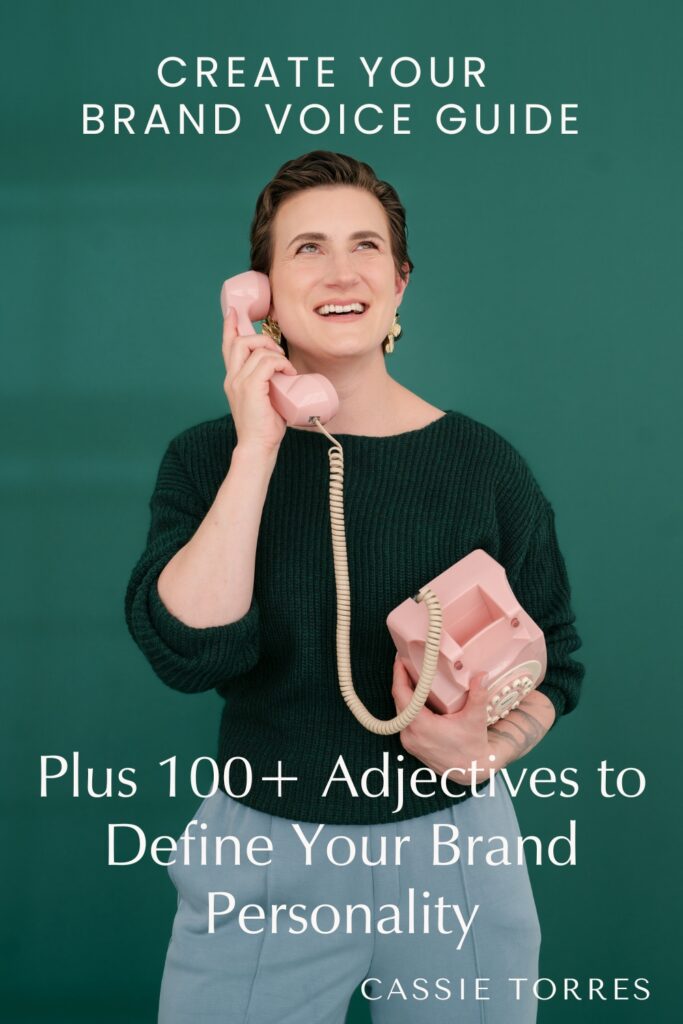
What is brand voice?
Put plainly, your brand voice is how you communicate your message to your audience. We’re not robots. Behind every brand is just people talking to people. By adding personality and tone to your brand, you can sound a lot more human when connecting with your people online.
Why is brand voice important?
Listen, I wish your beautiful work could stand on its own. (I’m not just saying this because people give me money to write their websites.)
The truth is that your audience is inundated with information. When they google “Connecticut photographer”, they’re gonna get a lot of results from a lot of amazing photographers. Sure, they may be captivated by your work, but pretty soon they might get fatigued and confused.
Your work is important, of course, but so is your brand’s message and how you convey that message.
Having a defined brand voice:
Gives you consistency
When you define your brand voice (see below!), you’ll have a guide to always refer back to. When you can write consistently between all platforms – think your website, social media, emails – it creates a brand that people can trust.
“She’s got her ish together,” your clients will say as they experience a consistent message everywhere they turn.
Makes you recognizable
When you’re consistent, you become recognizable.
Have you ever met a friend in a crowded place? A train station, park, busy coffee shop? You’re scanning the crowd and see them from a distance. Before you can even see the details on their face, you know it’s them. Just by their pure essence, you recognize their form.
Become that type of friend to your people – one that can get recognized in the crowd. (Kinda like how every time we see Dean Winter’s face pop up during a commercial break, we know it’s gonna be Mayhem from Allstate. Be like that, with maybe a little less chaos.)
Connects you to your customers
Personifying your brand gives your clients something to relate to and engage with. Even if you implement a lot of automation in your photography business (hint…you should be!), you can still pepper in personality and voice to connect to your customers and make them feel seen, heard, and like they’re interacting with a real human being.
Leads your customer to ACT
This is the ultimate goal – getting your audience to hit that “Book Now” button so you can serve more people. Brand voice includes personality, but it’s less about your personal personality and more about what will guide your customers to take action. If you hate getting all vulnerable and raw on the internet, this should free you (it’s not about you anyway, buddy…it’s all about your customer).
What’s the difference between brand voice and brand message?
Here’s what my brain looks like when I think about what makes a standout brand.
There’s three main components: Position, Message, and Voice. While I’m using a pie-graphy type of visual here, the anatomy of your brand is much more fluid and interconnected, and each element can inform the others. I tried to make this more blobby in Canva, but a graphic designer I am not, so this is what we’re gonna work with.
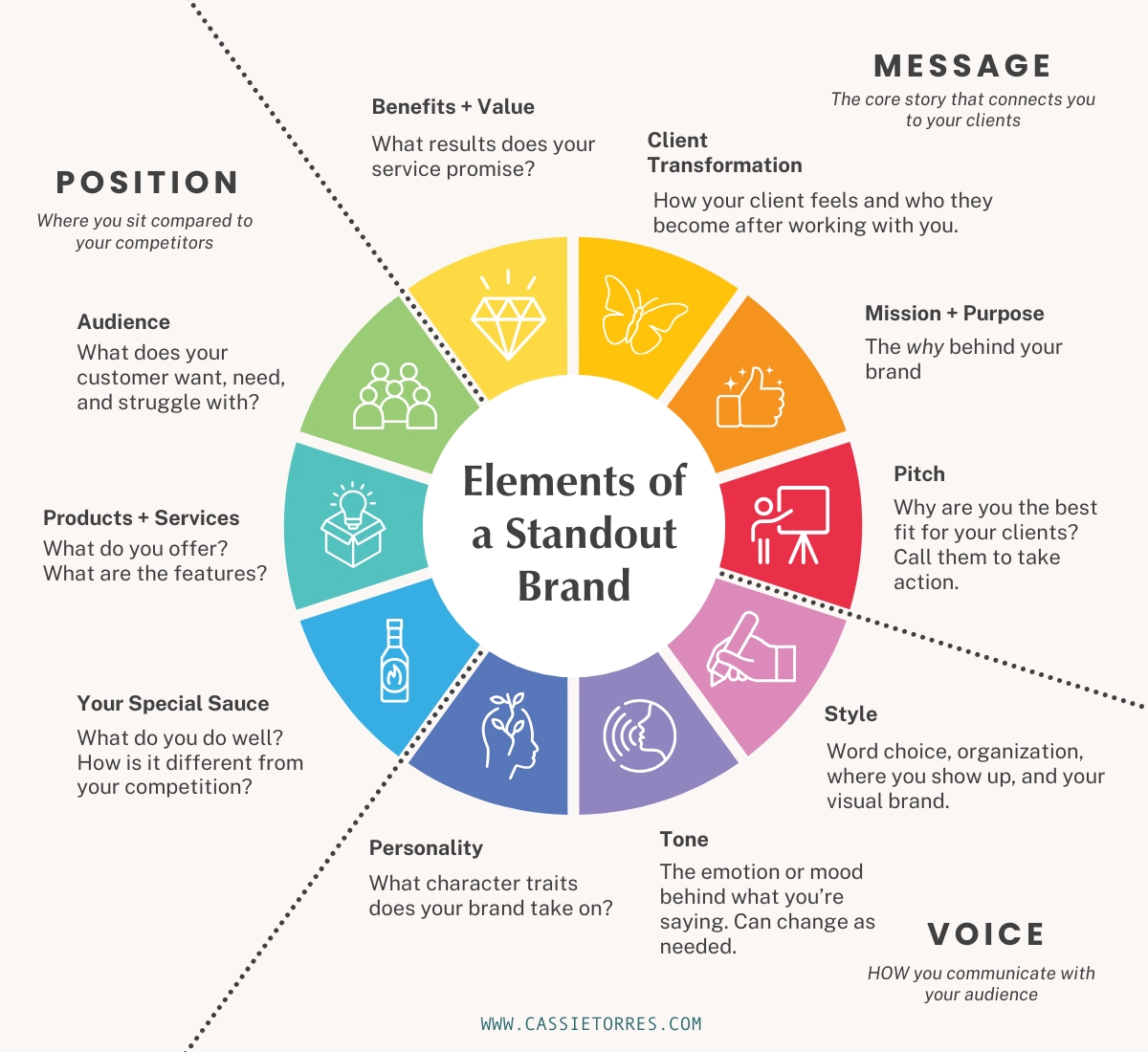
To summarize:
Brand Position = how you compare to your competitors in the marketplace (think about how if I want a burger, I can go to McDonalds or I can go to a fancy steak house)
Brand Message = The core story that connects your brand to your clients (what is the narrative and journey that you want to take your client on?)
Brand Voice = the way you communicate these things to your clients (are you dry and sarcastic or warm and inviting?)
Your Position and Message is what you’re all about. Your Voice is how you share it. It’s the difference between WHAT you’re communicating and HOW you’re communicating it.
What are Brand Voice Characteristics?
When it comes to communication, your Voice can be broken down even further into personality, tone, and style.
Personality is the way you personify your brand. If your brand was a person, what character traits would they have? Are they very formal and put together? Or more bohemian and always wearing yoga pants?
Tone is the emotion and mood behind the communication. How do you feel about the content, and likewise, what do you want your audience to feel about it?
Style is the words you choose, the stories you tell, and the mode in which you communicate. Are you all over instagram stories everyday, sharing your nitty gritty life details? Or do you post once a month with value packed informational content?
Or maybe we can describe it like this:
Imagine showing up to a party.
Brand personality is who you are to the core when you show up to the party (Are you an introvert? Ready to party? Looking for your closest friend or the nearest dog?).
Brand tone is how you introduce yourself and interact with the party guests (Do you announce your arrival with an “I have arrived!” or do you walk up to every guest and give them awkwardly long hugs?).
Brand style is how you’re dressed and the way you present yourself (Do you wear sunglasses inside like a celebrity? Do you listen more than you talk? Are you flashy and give quick one liners?)
It’s a mix and match situation, but the key is to be consistent. For example, an introvert who hates being looked at would probably not announce their arrival while wearing a dress made out of disco balls. Likewise, a more formal and refined brand probably wouldn’t say “OMG, that is so sus…” or whatever the kids are saying these days.
What is brand tone?
If you’re confused about tone, think about a teenager (or 5 year old, let’s be honest) saying “I’m sorry.” The same two words can take on vastly different tones based on what they actually believe. If they are truly repentant, their “I’m sorry” will take on a sincere and even pleading tone. If they’re not sorry in the slightest bit or are being forced to say it, their “I’m sorry” will be sarcastic, exasperated, or downright mean.

I took my 5 year old to see Inside Out 2, and while I wasn’t ready to explain puberty to him in a dark theatre, I had to stop myself from giving a standing ovation during the Sar-Chasm scene.
Riley’s emotions set out on another adventure, this time in a teen psyche, and they come across the sar-chasm, a giant crevasse that twists words into a sarcastic tone (it’s genius).
You see the characters calling for help across the void, but what comes out on the other end is pure sarcasm. They say “we really need your help!” and it comes out as “We reaaAAalllyyy neeeed your heeeEEEllllLLLppPP.”
It’s the same words, different tone.
Comparing Brand Tone Examples
Likewise, we can have a similar message as another business but communicate it in a different tone. This is just one other way that we can differentiate ourselves and stand out.
If you’re old like me, you’ll remember Sarah Mcchlaclan bringing you to tears after school. The ASPCA used In the Arms of an Angel over videos of shaking and terrified shelter pets.
The message…animals need help. Please adopt and donate.
The tone…sad. Really really sad.
The result…making you cry… and hopefully taking out your wallet.
Meanwhile, New England Puppy Rescue is another animal shelter with a different approach.
The message…animals need help. Please adopt and donate.
But the tone…optimistic, fun, and future-casting. They paint a picture of how joyful it could be to adopt a dog…by literally having “painting with pups” days. They use fun pictures that show off the pets’ personalities and a playful and enthusiastic hashtag like #saveallthepuppies.
The result…hopefully also getting people to take out their wallets and adopt a dog. But this time, only happy tears are allowed.
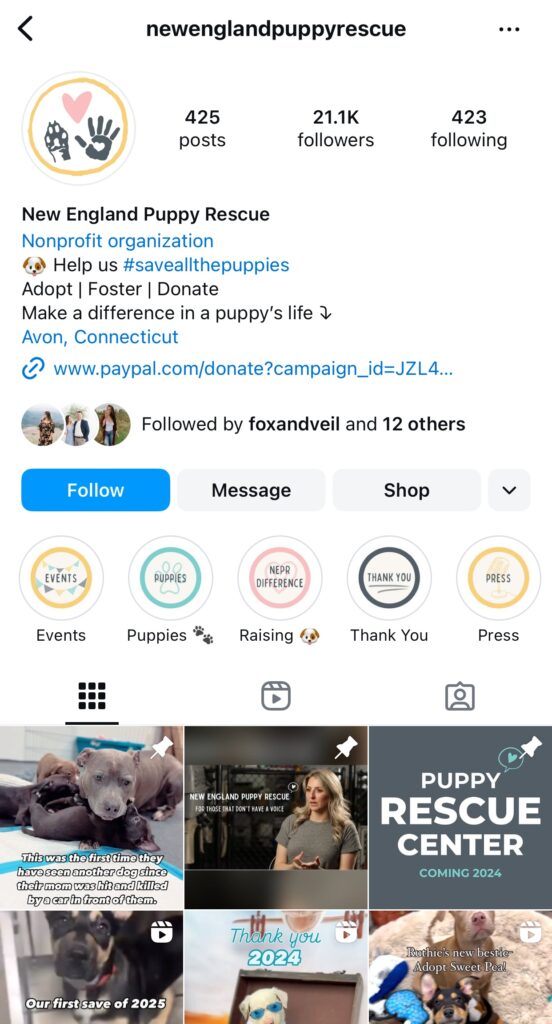
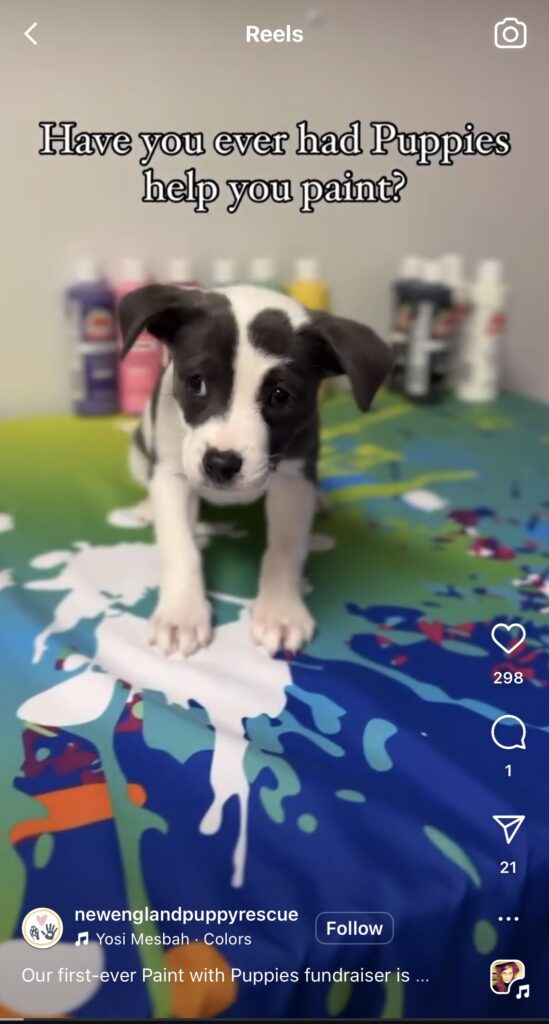
Tone is the outward expression of a brand’s personality.
If your brand’s personality is competent and always one step ahead, then your tone is helpful and happy to go out of your way, peppering your responses with “my pleasure!”
It’s important to note that tone can change! It depends on what you’re trying to communicate and to whom. If you’re a lighthearted and fun brand, but you have to send your team an email about budget cuts, you probably aren’t gonna throw in any “Lol’s”.
Do I need to find my brand voice if I’m a personal brand?
When you’re a personal brand or a solopreneur like a photographer, wedding planner, or massage therapist, you may think your brand’s personality needs to match yours. Yes, in a sense this is true. When you’re working one on one with clients, there needs to be consistency between who you actually are and how your brand comes across. You shouldn’t write all the copy on your brand to be really dry and boring when you’re actually hilarious and full of sarcasm in real life.
Yes, when “me myself and I” is the face of your brand (and when you say “we” on your website, you mean you and your dog) then ya…your brand’s personality is gonna be related to your real personality.
So why can’t you just write “like yourself” and have that be enough? If I put no thought into it, won’t it come across as my voice by default?
Eh…maybe. But most people speak differently than they write or don’t know how to actually make their writing sound like them.
Think of your Voice like stage make up for your brand. We want to highlight those personality traits so that they’re recognizable from a distance – elevating your brand and making you stand out. (Remember that friend in the crowded train station)
How to discover your brand voice:
Now that we’ve broken it down, let’s get to work and actually get you to define your brand voice!
First, hone in on your message
It’s ok if you want to get started with the brand voice and personality, but it will be much more effective if you have your Message and Position dialed down first. Most importantly, you want to know who you are talking to and what you actually need to talk about.
Personality without substance creates a shallow brand.
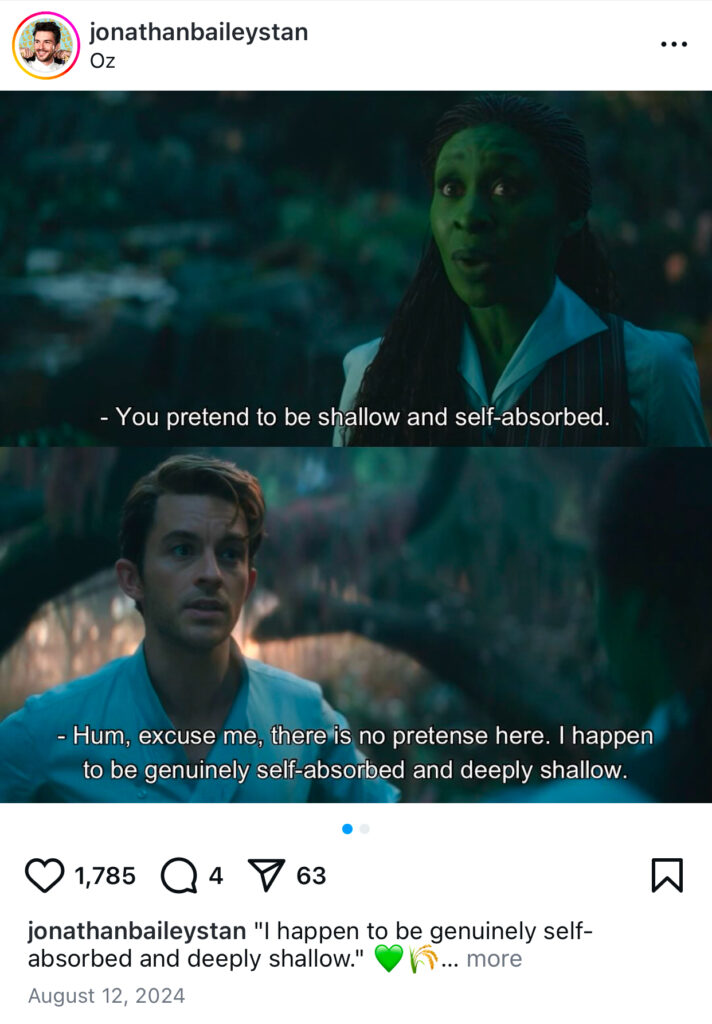
Then, decide HOW you’re going to talk about that message
As promised, I’ve got a list of adjectives for you. But before you dive into that, here are some fun reflection questions to get you thinking about your brand’s personality.
- Are there any “sister brands” your clients tend to associate you with? For example, do you always celebrate with a bottle of Veuve? Or Doritos?
- What’s the one thing you want to be known for as a business?
- What do you want people to feel as they interact with you online?
- What slang words or expressions do you use all the time?
- What are you like in person? How would your friends and family members describe you? (are you funny, warm, romantic?)
- If you could have a fictional character, either from a book or movie/show, to do all your writing for you, who would it be?
- If there was a movie made of your business, who would play it?
- If your brand were a genre of music, what would it be?
- If you were throwing a party for all your clients or employees, what type of party would it be? A fancy soiree? A bonfire at the beach?
- What kind of animal would your brand be? An overeager golden retriever? A coy and sexy leopard? A fast and scurrying squirrel?
- Sometimes it helps to think about what you DON’T want to be like (I’m NOT formal!)
- Or, think about whittling down your personality even more with “I’m _____ by not ______”. For example, “I’m formal but NOT stuffy.”
100+ Brand Voice Adjectives: Stand out with a defined personality
Ok here’s a list to break it down for you a bit. Note that this isn’t exhaustive by any means, but a quick guide to get you started on your brand voice. If one of these words is not quite right, one of my favorite resources is Onelook.com. Use their thesaurus/related words feature to find others that might fit your vision better.
Playful & Fun
- Goofy
- Silly
- Spunky
- Witty
- Amusing
- Irreverent
- Zany
- Lighthearted
- Cute
Warm & Welcoming
- Kind
- Warm
- Sweet
- Gentle
- Gracious
- Welcoming
- Approachable
- Friendly
- Easy-going
Supportive & Thoughtful
- Nurturing
- Reassuring
- Supportive
- Gracious
- Thoughtful
- Soothing
- Mindful
- Helpful
- Grounded
Bold & Confident
- Bold
- Confident
- Fiery
- Daring
- Direct
- Firm
- Authoritative
- Sharp
- Unapologetic
Creative & Artistic
- Artistic
- Imaginative
- Poetic
- Metaphorical
- Story-driven
- Visionary
- Dreamy
- Experimental
- Bohemian
- Free-spirited
- Whimsical
Smart & Innovative
- Knowledgeable
- Intelligent
- Informative
- Curious
- Technical
Charming & Elegant
- Elegant
- Posh
- Polished
- Cultured
- Refined
- Sophisticated
Emotional & Inspirational
- Joyful
- Motivational
- Romantic
- Vulnerable
- Deep
- Optimistic
- Reflective
Quirky & Intellectual
- Eccentric
- Offbeat
- Geeky
- Snarky
- Sarcastic
- Dry
- Quirky
Serious & Formal
- Serious
- Formal
- Respectful
- Cautious
- Humble
- Calm
Energetic & Spontaneous
- Energetic
- Spontaneous
- Upbeat
- Raw
- Chatty
- Sassy
Edgy & Cool
- Edgy
- Shocking
- Cool
- Rebellious
- No-Nonsense
- Strong-willed
- Fierce
- Trendy
- Laid back
How to implement your brand voice?
Here’s the thing…You can make a list like “sassy, no-nonsense, and intelligent” but what does that actually look like? Picking adjectives for your brand means nothing if you don’t know how to implement it and make that tone come across.
Back in my English teacher days, I would drill “show don’t tell” into my students’ brains, especially during creative writing and personal narrative lessons. What’s better – to say “he was a mean man” or “his smile was all teeth, sharp and pointed, waiting to feast on his enemy’s flesh.”
You can say all day that your brand is warm and approachable, but if your words don’t feel like a warm hug, no one is going to believe you. Your visuals can definitely show your personality, but pair it with the tone in your writing and you’ve got a cohesive brand voice.
Without getting all English teachery on you, here are some tangible ways you can put your brand voice into practice:
The words you use
Ok here’s where I’ll let you break out the thesaurus. But we’re not trying to find the fanciest words to impress anyone or get a good grade. Instead, we want to choose the right words that relate to your tone and message.
For example, iIf you want to say that something is Amazing, you’ve got a few choices:
“It was stunning” gives off a more charming and refined tone.
“It was pure magic” sounds more artsy and in awe over the wonder of the world.
“That was unreal” could lend itself to a more casual and energetic tone with a little bit of edge.
Likewise, a warm friend who wants to give you a virtual hug might sign off with an “XO, Sally” while a more formal brand might say “Talk Soon, Bob.”
The references you make
When you’re trying to paint a picture for your audience are you making references to Dave Matthew’s Band or Chappell Roan?
Do your metaphors relate to current pop culture icons or figures from the Golden Age of Hollywood?
All of these “sister” brands, ideas, and references can help solidify your voice.
Sentence length
Short sentences make things punchy.
But long sentences like this, with lots of commas, can send your reader on a lilting journey into a forest of warm light dappling through the trees.
Kinda lost myself there, but you get the point. Think about how your brand might talk as it relates to sentence length.
Punctuation
Are you using commas or are you just letting your reader speed through your sentences in a zany way?
Do you love an exclamation point? Ellipses? Periods to emphasize a word?
Personally, I love parentheses – You can give side thoughts or even break the fourth wall with a couple of ‘em (like this).
The format of your words
This is where you get to put on your designer hat and give your words even more personality.
When you’re emphasizing a thought, will you use italics, bold, underline? Will emojis pepper your sentences and be your bullet points?
Using a checkmark emoji for a bulleted list can make you seem organized, put together, and serious while using flowers can make your words feel feminine and cute.
How to create your brand voice guide:
Let’s create a concise Brand Voice Guide that you can refer back to everyday! Go ahead and copy and paste this into a Google Doc. Print it out and keep it nearby whenever you need to create a piece of content.
Let’s put it all together, Mad Libs style!
- My customer is:
- And they want:
- I uniquely solve their problem by:
- I want them to feel:
- And I want them to do:
- My brand’s personality is: (can include here the NOT statements from above)
- So I often communicate with them in this tone:
- Which means my writing looks like this: (here you can include exactly how you will give off this tone. Think of your sentence length, the words you’ll use, the references you’ll make etc.).
A Brand Voice example for a food photographer:
- My customer is: Connecticut chefs and restaurant owners who cook with love and are always adding new foods to their menu
- And they want: more people to walk into their restaurant because they saw a photo that made them hungry
- I uniquely solve their problem by: creating modern photos of their food that show off the texture in dynamic light
- I want them to feel: blown away by their photos and like the photos bring them to the cutting edge of the industry, a little avante garde, and excited to push their restaurant forward
- And I want them to do: slide into my DMs with a lot of exclamation points, wanting photos of their food that look like my portfolio
- My brand’s personality is: Edgy, cool, and artistic. My brand is artistic but not fluffy. My brand is edgy but not rebellious.
- So I often communicate with them in this tone: No-nonsense while still being laid back
- Which means my writing looks like this: Skipping over small talk (chefs have no time to read), using short punchy sentences, staying in the active voice. Keeping exclamation points to a minimum without any excessive excitement. Getting rid of any fluff and show that I’m confident by saying things directly without skirting around my message. I’m not going to talk about long stories, but get right to the point after a simple hook. Imagine James Bond or Clint Eastwood – calm, cool, direct, gets the job done without making a big fuss about it.
How to use Chat GPT to help you define your brand voice.
Don’t come at me for enlisting the help of robots sometimes. I know we started this post with “we’re just people talking to people.” I still hold to that. Here’s what the robots are good at though: organizing your thoughts and helping you see new perspectives.
Never take what they spit out and plop it on your website. Instead, use AI like a personalized Google assistant to help you with projects…like this one!
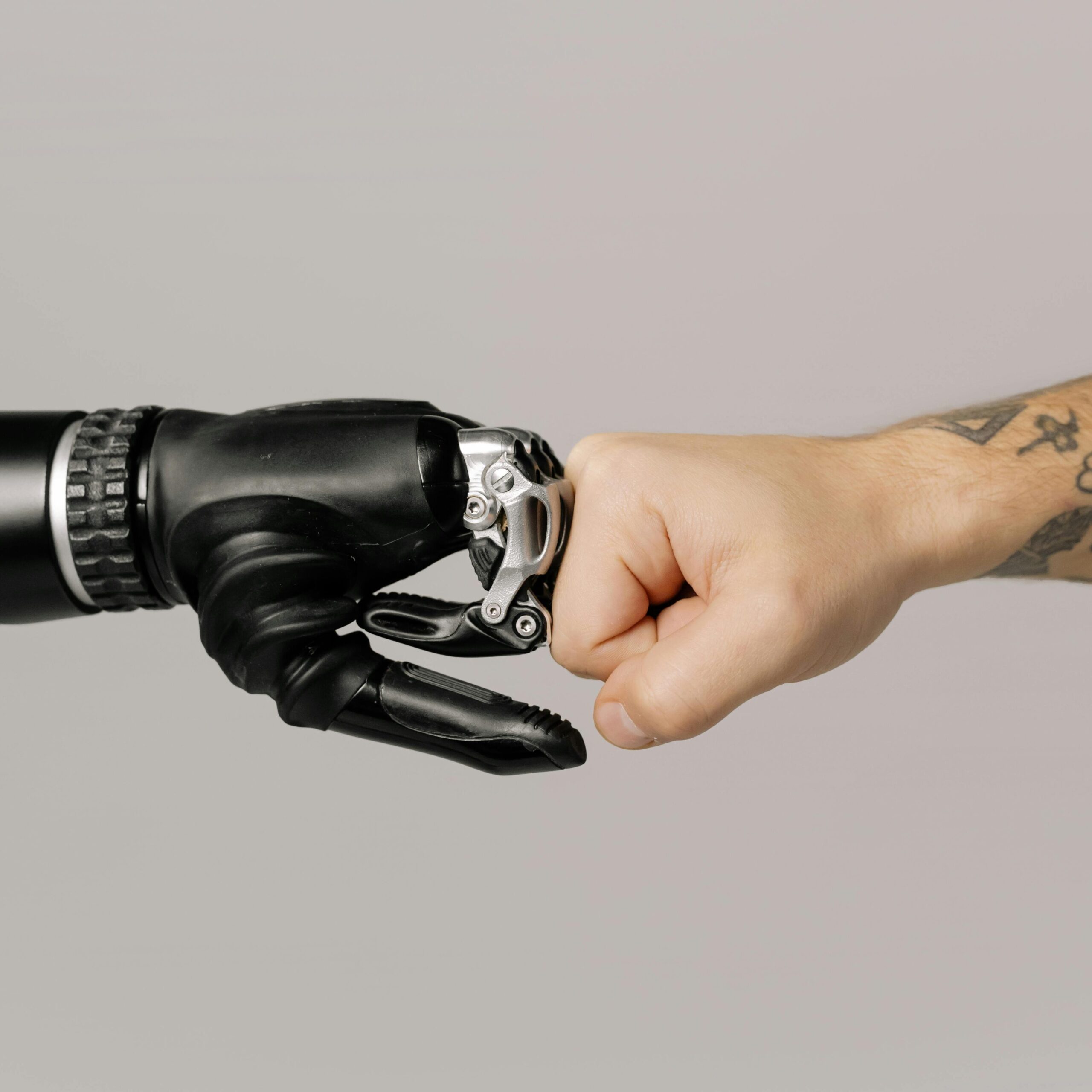
Here’s a few ways you can use ChatGPT to help find your voice:
- Ask it to analyze your website, instagram, or any other piece of writing. Tell it a little bit about what you do, copy and paste the URL or text, and ask a question like: “How would you describe my brand’s voice? Please give me three specific adjectives.”
- Once you have your brand voice adjectives, either by creating it yourself or asking ChatGPT for help, ask it to teach you how to write in that tone! Again, tell it a little bit about who you are and what you do. Tell it that you would like your writing to be in a certain tone. Then say “Can you teach me how to write content for my brand in this way? I’d like specific guidelines like sentence structure and length, what type of words to use, what references to make, and any other elements of language you find relevant to convey that tone on my website and social media.”
- Can’t quite decide on what your brand voice should be? Research! Plug in a few websites or social media handles of brands that you admire and ask ChatGPT to analyze them for tone and voice. You don’t ever want to copy them, but it helps to do research and understand why you feel connected to certain brands, especially if you’re still a little fuzzy on this whole thing.
Wedding Photographer Client Questionnaires and Email Templates
If you’re a wedding photographer and you’re like great, I’ve established my brand voice but now I still have to do all the writing, I’ve got something for you that might help!
After a decade of photographing weddings, I’ve decided to hang up my cameras (cancer made me do it, really), and make all of my client templates available for you.
When you get your email and client questionnaire templates, you’ll receive both a PDF guide AND a plain Google Doc version. Go ahead and copy and paste the emails and questions into ChatGPT, and tell it to rewrite the emails to match your brand voice guide.
Tweak as needed to make sure it follows exactly what you want to convey (see: don’t plop anything it says directly onto your website).
As a reader of this blog, you can get 10% off any of my templates in the shop! Sign up HERE to get your discount code.
Be the first to comment